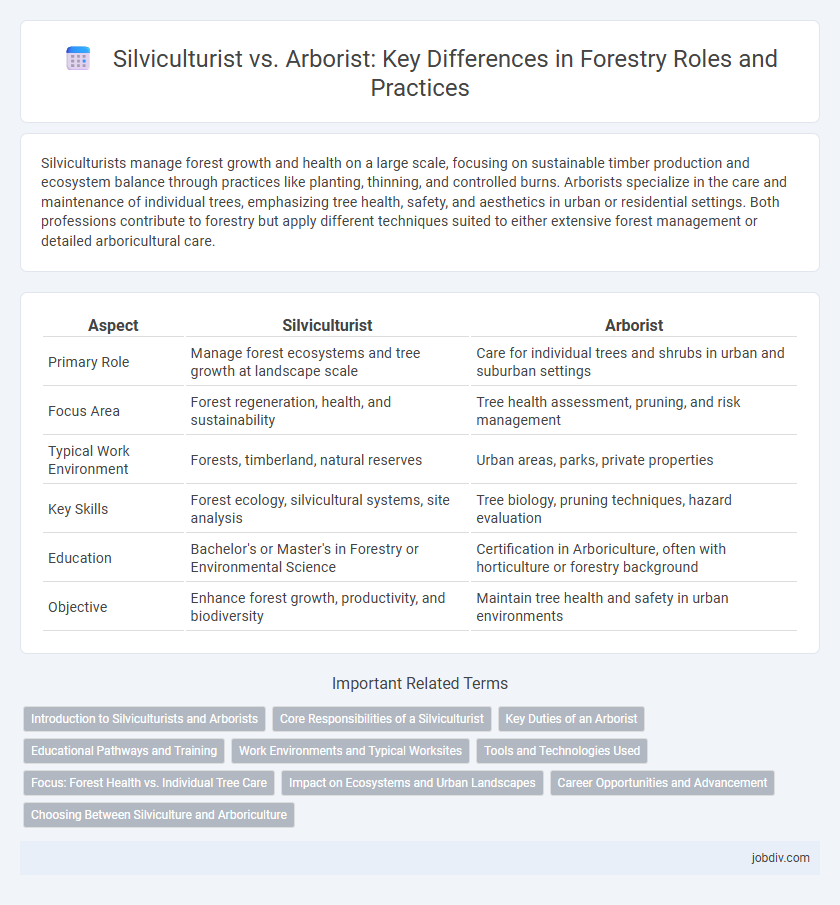Silviculturists manage forest growth and health on a large scale, focusing on sustainable timber production and ecosystem balance through practices like planting, thinning, and controlled burns. Arborists specialize in the care and maintenance of individual trees, emphasizing tree health, safety, and aesthetics in urban or residential settings. Both professions contribute to forestry but apply different techniques suited to either extensive forest management or detailed arboricultural care.
Table of Comparison
| Aspect | Silviculturist | Arborist |
|---|---|---|
| Primary Role | Manage forest ecosystems and tree growth at landscape scale | Care for individual trees and shrubs in urban and suburban settings |
| Focus Area | Forest regeneration, health, and sustainability | Tree health assessment, pruning, and risk management |
| Typical Work Environment | Forests, timberland, natural reserves | Urban areas, parks, private properties |
| Key Skills | Forest ecology, silvicultural systems, site analysis | Tree biology, pruning techniques, hazard evaluation |
| Education | Bachelor's or Master's in Forestry or Environmental Science | Certification in Arboriculture, often with horticulture or forestry background |
| Objective | Enhance forest growth, productivity, and biodiversity | Maintain tree health and safety in urban environments |
Introduction to Silviculturists and Arborists
Silviculturists specialize in managing forest ecosystems, focusing on tree growth, health, and sustainable harvesting practices to ensure long-term forest productivity. Arborists concentrate on the care and maintenance of individual trees, emphasizing pruning, disease management, and urban tree health to enhance safety and aesthetics. Both professions play critical roles in forestry, with silviculturists managing forest landscapes and arborists maintaining tree vitality in urban and suburban environments.
Core Responsibilities of a Silviculturist
Silviculturists specialize in managing forest ecosystems, focusing on the regeneration, growth, and health of trees to ensure sustainable timber production and biodiversity conservation. Their core responsibilities include developing and implementing forest management plans, conducting site assessments, and applying techniques such as thinning, pruning, and controlled burns to enhance forest productivity. Unlike arborists who concentrate on individual tree care in urban environments, silviculturists work at a landscape level to optimize forest resources and ecological balance.
Key Duties of an Arborist
Arborists specialize in the care and maintenance of individual trees, focusing on tasks such as pruning, diagnosing diseases, and ensuring the overall health of urban and suburban trees. They assess tree risk, perform tree planting, and manage pest control to enhance tree longevity and safety in landscapes. Unlike silviculturists who manage forest ecosystems, arborists provide targeted care to trees within developed environments.
Educational Pathways and Training
Silviculturists typically hold degrees in forestry, natural resource management, or environmental science, emphasizing ecosystem management, forest regeneration, and sustainable timber production through specialized university programs and field research. Arborists often pursue certifications such as the International Society of Arboriculture (ISA) Certified Arborist credential, combining horticultural knowledge with practical tree care training through apprenticeships and technical courses. Both pathways demand extensive knowledge of tree biology, but silviculturists focus on forest ecosystems at scale, while arborists specialize in individual tree health and urban forestry maintenance.
Work Environments and Typical Worksites
Silviculturists primarily work in forested areas, managing large-scale ecosystems and conducting research in national forests, plantations, and conservation areas to promote sustainable timber production and biodiversity. Arborists typically operate in urban or suburban environments, focusing on individual trees in parks, streets, residential landscapes, and commercial properties for health assessment, pruning, and maintenance. Both professions require specialized knowledge of tree species, but silviculturists emphasize ecosystem-level management, while arborists concentrate on tree care in developed environments.
Tools and Technologies Used
Silviculturists typically use remote sensing technologies, GIS software, and drones for forest management and monitoring, allowing precise data collection over large areas. Arborists rely on specialized hand tools such as pruning shears, climbing gear, and aerial lifts, combined with diagnostic equipment like resistographs and tree health meters to maintain individual trees. Both professionals incorporate advanced mapping tools and data analysis software to enhance decision-making in their respective fields.
Focus: Forest Health vs. Individual Tree Care
Silviculturists specialize in forest health by managing tree populations, regeneration, and ecosystem sustainability to maintain balanced and productive forests. Arborists focus on individual tree care, providing expertise in pruning, disease treatment, and structural maintenance to enhance the health and longevity of single trees. Both roles contribute to tree management, but silviculturists address broader forest dynamics while arborists prioritize the well-being of individual trees.
Impact on Ecosystems and Urban Landscapes
Silviculturists manage forest ecosystems by applying scientific principles to promote sustainable growth, biodiversity, and ecosystem resilience, directly influencing large-scale forest health and carbon sequestration. Arborists focus on the care and maintenance of individual trees in urban landscapes, enhancing tree longevity, aesthetic value, and local air quality while mitigating risks associated with urban tree decline. Both professions contribute uniquely to ecosystem services, with silviculturists prioritizing forest ecosystem dynamics and arborists addressing urban environmental challenges.
Career Opportunities and Advancement
Silviculturists specialize in forest management and ecosystem sustainability, focusing on large-scale timber production and conservation, which offers career opportunities in government agencies, forestry consulting firms, and environmental organizations. Arborists concentrate on individual tree care in urban and suburban settings, providing services such as tree health assessments and maintenance, with advancement options in landscaping companies, municipal parks departments, and tree care businesses. Both professions allow for growth through certifications like Certified Forester for silviculturists and International Society of Arboriculture (ISA) Certified Arborist credentials, enhancing job prospects and leadership roles.
Choosing Between Silviculture and Arboriculture
Choosing between silviculture and arboriculture depends on the scale and purpose of tree management; silviculture focuses on managing forests for timber production, biodiversity, and ecosystem health, while arboriculture emphasizes the care and maintenance of individual trees typically in urban or suburban settings. Silviculturists implement techniques such as controlled burns, thinning, and reforestation to optimize forest growth and sustainability, whereas arborists perform pruning, disease treatment, and hazard assessment to enhance tree health and safety. Understanding the ecological impact, desired outcomes, and spatial context is essential for selecting the appropriate practice in forestry management.
Silviculturist vs Arborist Infographic

 jobdiv.com
jobdiv.com